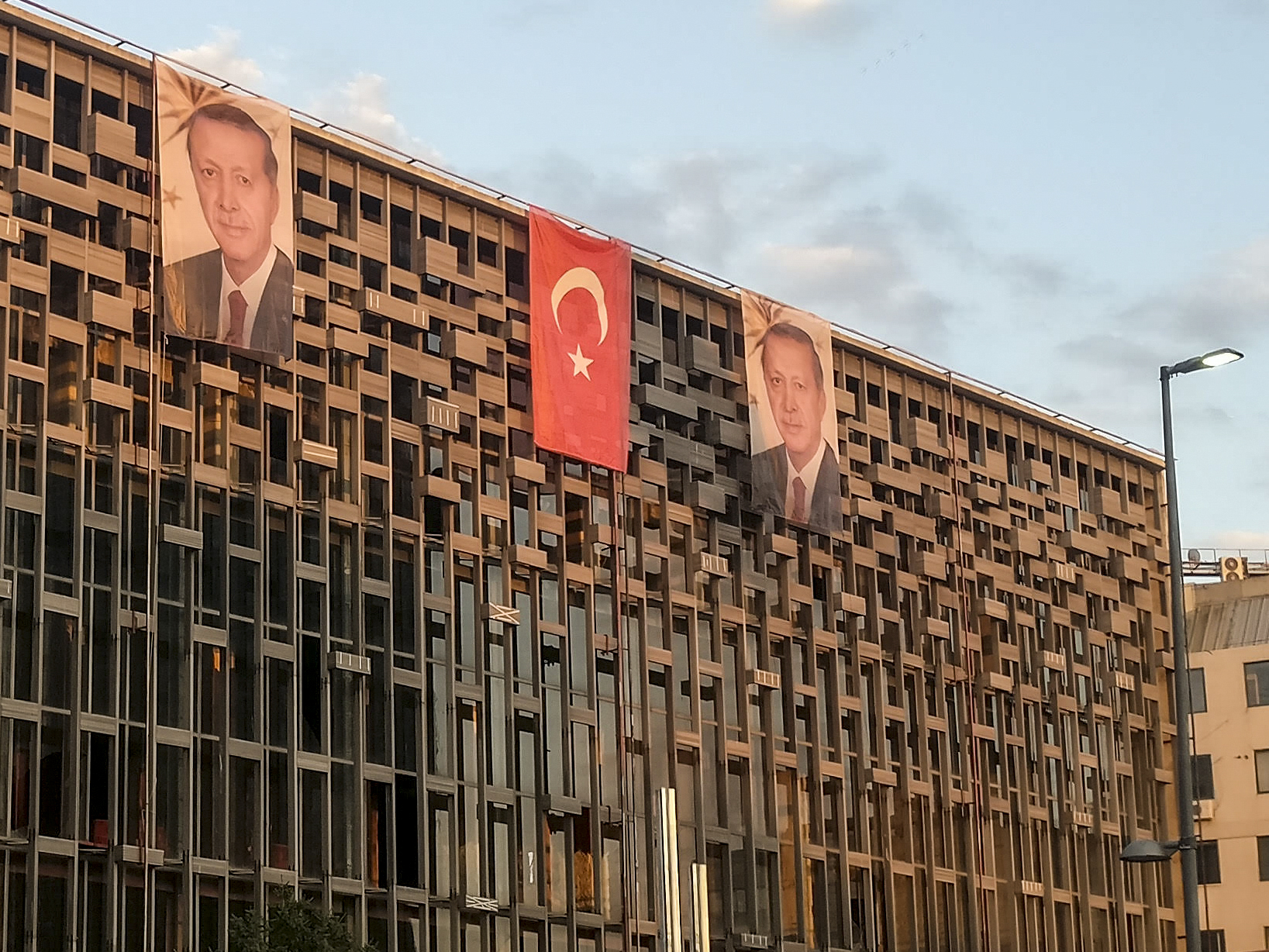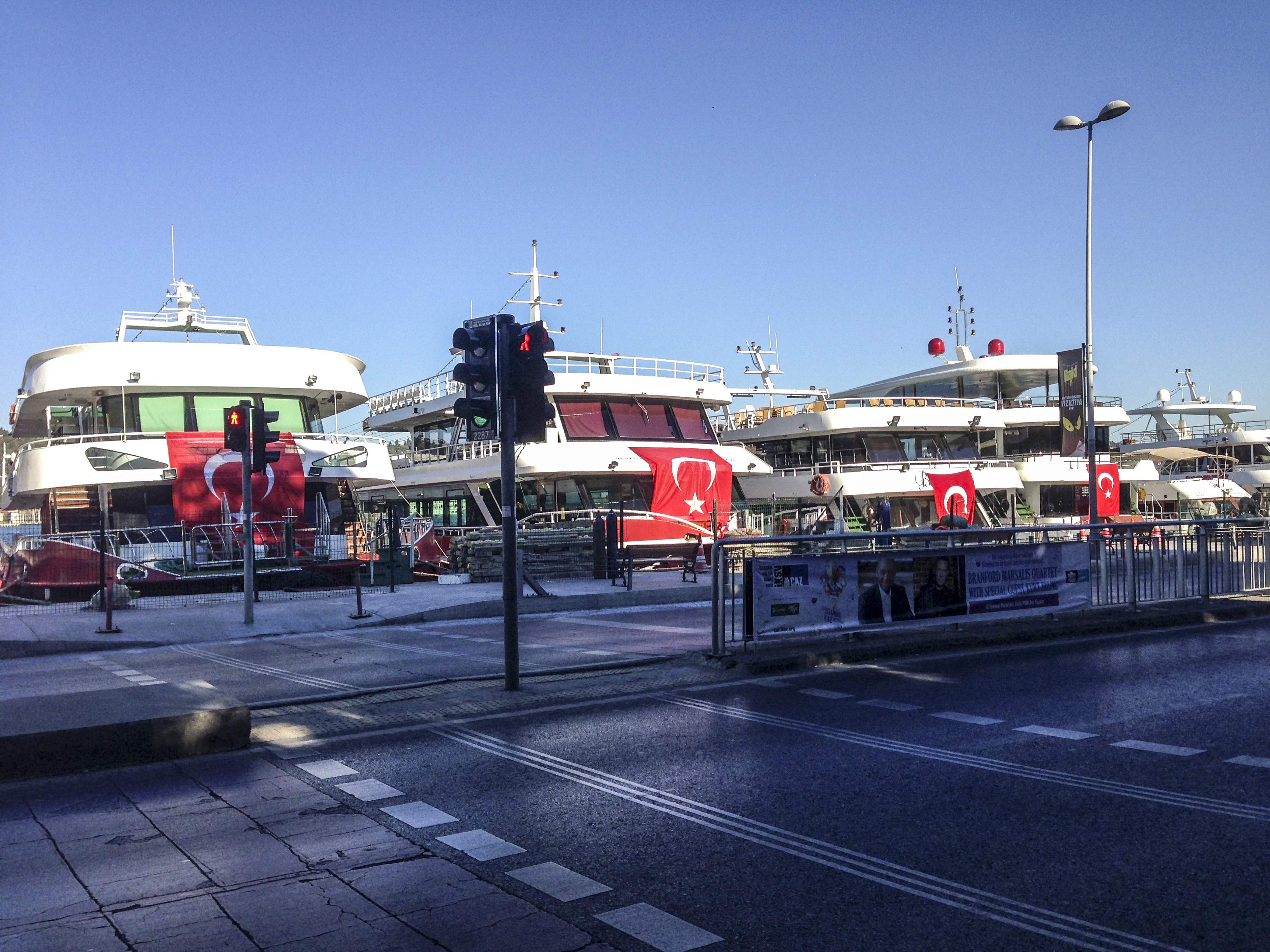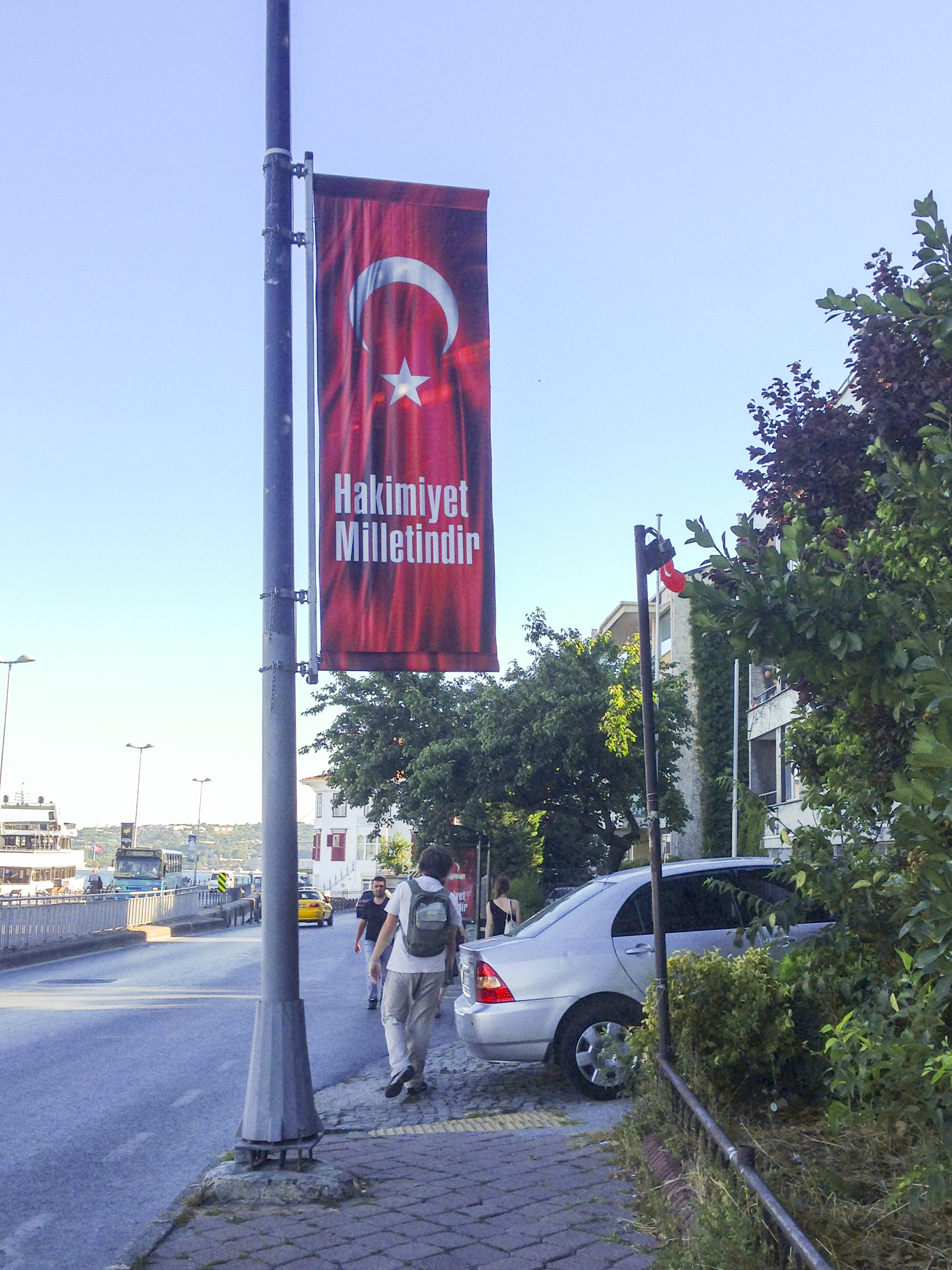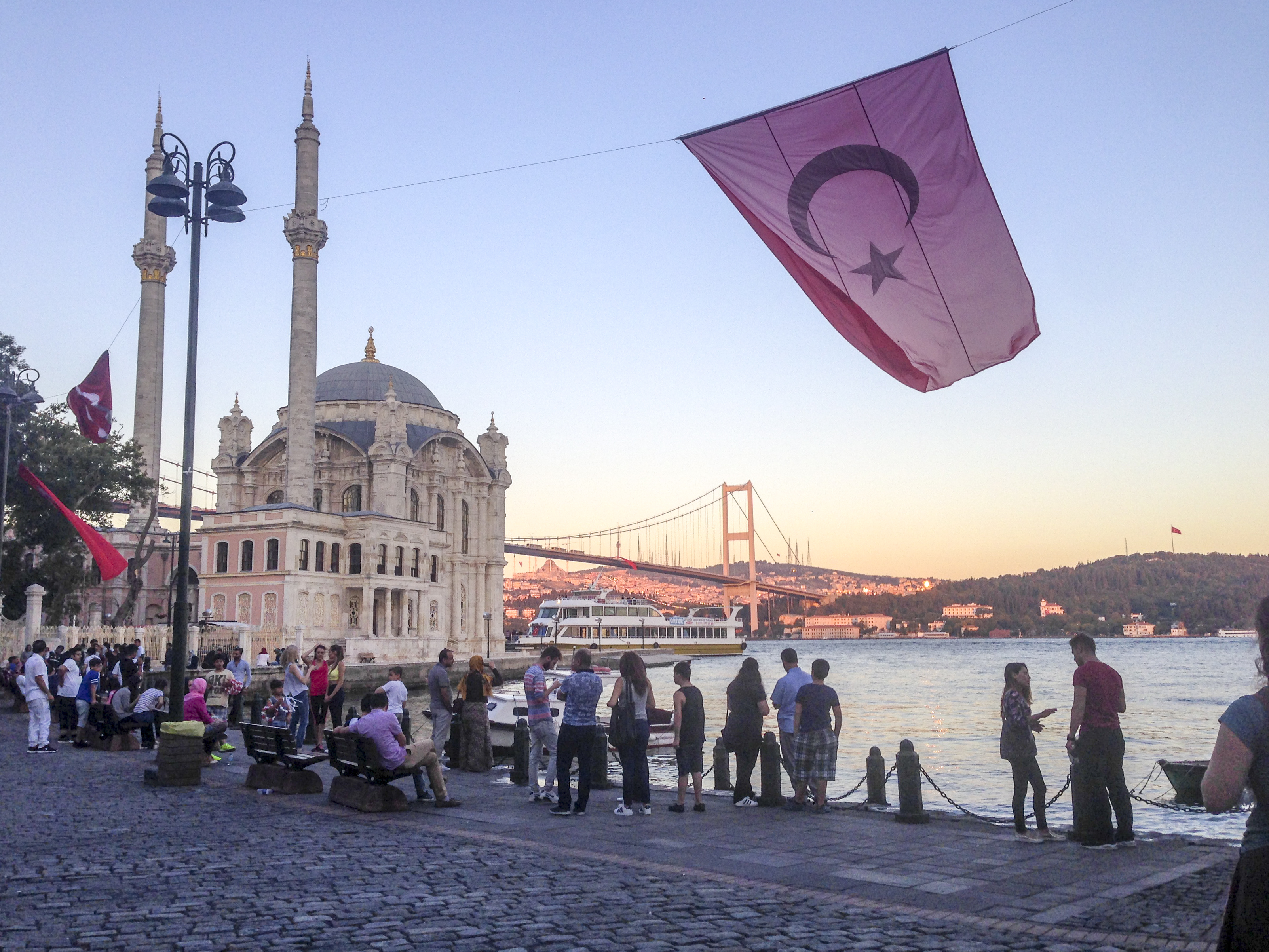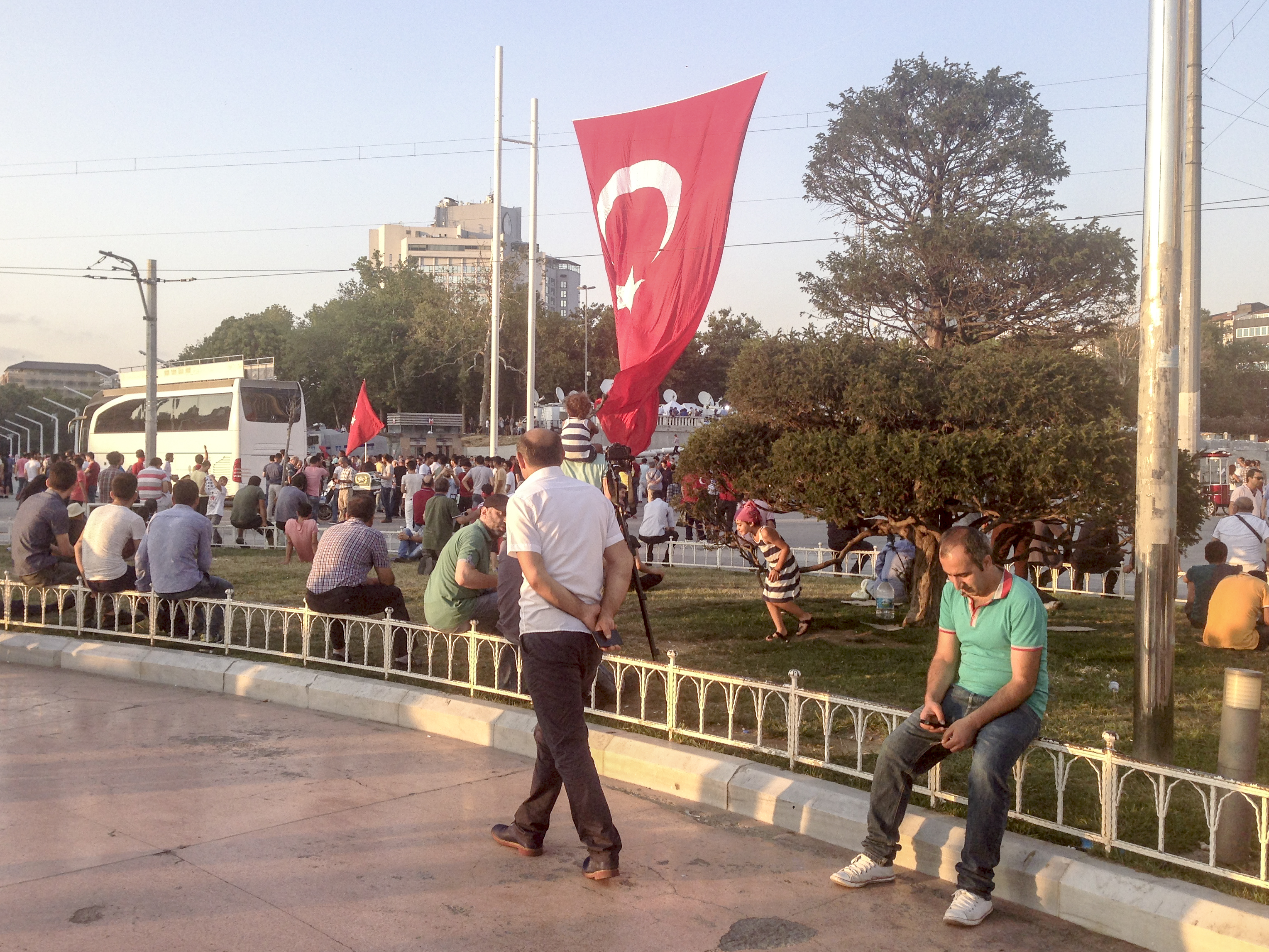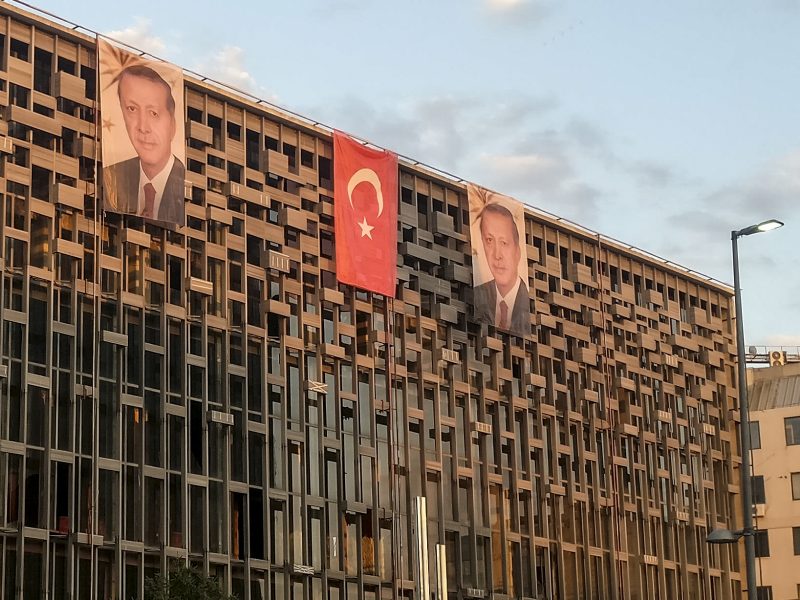
6 Photos
Anja Petrovic arrives in Istanbul on the same day as the attempted Turkish coup.
It’s been a few days now since I returned from Istanbul, where I witnessed tumultuous events that have shaken Turkey, with repercussions that could threaten the entire region. The following started as a sort of diary to help me record personal memories of a historic time in the country, and to share them with those who wondered what it was like to be there.
***
It’s early in the morning on July 15th. I check my bags one final time before heading to the airport, excited that the LeftEast convergence (the term used by organizers to emphasize the conversation-based nature of the event and to differentiate it from a formal conference) on people’s movements was bringing me to Istanbul for the first time and would reunite me with some old friends.
One short flight later — a reminder of just how close Istanbul really is to Belgrade — I find myself in a long passport control queue. The crowd is so diverse it feels like the entire world fits into it. While waiting, I decide to finish reading an article recommended by the convergence organizers entitled “The ‘New Turkey’: Fetishizing Growth with Fatal Results.” The piece provides insights into neoliberal profit-making tactics enforced by Turkish President Erdoğan, including the ruthless exploitation of resources and disregard for human life and the environment. I immediately relate the situation in the country – albeit on a different scale – to that of Serbia and honestly wonder if our government looks to these techniques as case studies in a manual. A friend from Montenegro would later share the same concern for the situation in her country.
The Istanbul metro runs through the suburbs above ground, providing a glimpse of the extensive, densely populated residential neighborhoods that are home to some of the 15 million residents of the city. Inside the train, screens display YouTube-like videos of kittens, puppies and babies – an irresistible, yet somewhat strange sight. Perhaps it was a calming strategy implemented in the aftermath of the terrorist attack at Ataturk airport, which had happened just a few weeks before.
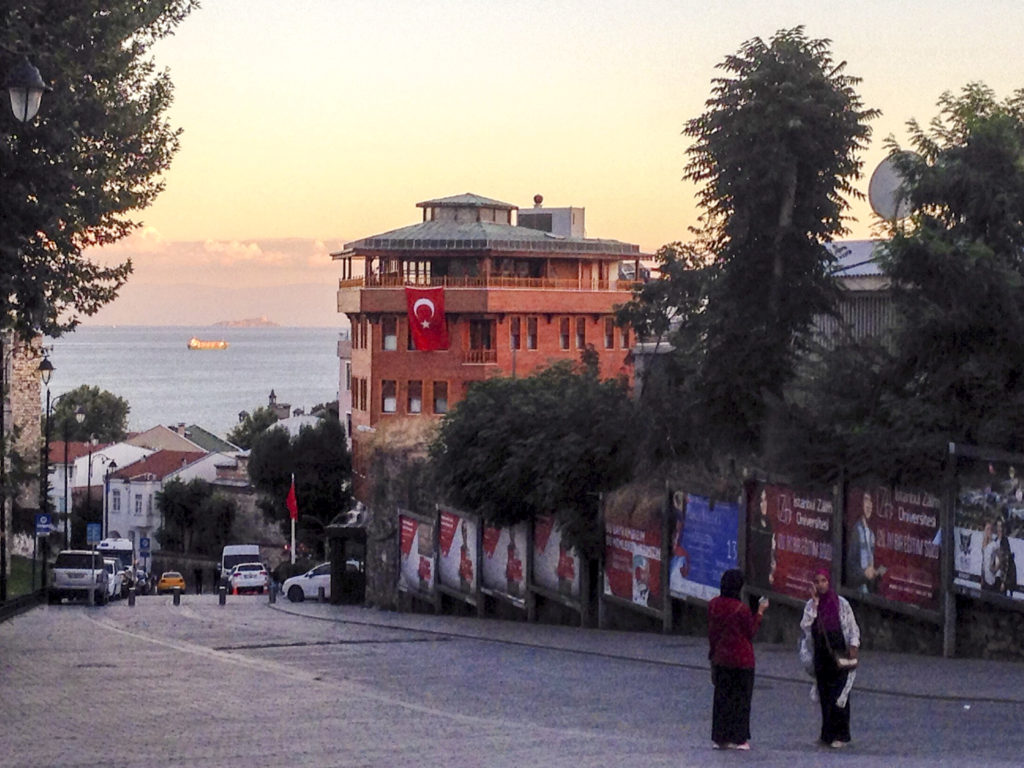
After a while, I emerge at the Şişhane metro exit, greeted by my friend Sonja. The neighborhood is crowded with beige buildings and has a view of the city bathed in afternoon sunlight. We briefly explore the central neighborhood of Karaköy before heading towards the university where the LeftEast gathering is about to begin.
After hanging out with the group for a while, I decide to go to bed early and get a good night’s sleep, unaware of what has already begun to unfold. At around midnight, I am awoken by a heavy knocking at my door. Sonja’s voice is urging me to get up. She is trying to explain that a military coup is underway. I hear the words ‘gunshots’ and ‘bombing’ and my heart starts to pound, partly due to the information I’m struggling to take in, and partly because of the sudden disruption of sleep. Still not quite awake, and in a state of disbelief, I pick up my phone. I discover several messages, all of them ending in question marks. This is really happening.
The university campus is located in a secular neighborhood away from the city center. It’s been heavily guarded since a bomb scare earlier this year. I think to myself that it’s the best possible place in town to be at right now. In the coming days, I will learn that friends who stayed in the very center had a much different experience.
Outside the dorm, faces are lit by phone and computer screens. Many local media outlets are no longer broadcasting, as they’ve been taken over by plotters of the coup. Social media has taken the lead in disseminating news. #TurkeyCoup is trending on Twitter, but information is jumbled and limited. A visibly shaken student from Turkey is translating the local news for us. Erdoğan urges people to go out into the streets to confront the army in the name of democracy. Eventually, the crowd manages to corner the soldiers. From time to time, the sound of a news anchor’s voice is drowned out by the noise of distant gunfire, helicopters and jets flying over us, and a sela prayer coming from nearby mosques, calling people out to the street. Around 3 am, we slowly begin to assemble the puzzle of recent events. Many things remain unclear — particularly the coup plotters’ ideological stance — but the most important information is that the coup has failed and that Erdoğan has regained control, as the trending hashtag #TurkeyCoupAttempt confirms.
“I hope this means there won’t be a civil war or sealed borders,” I think to myself.

Falling back asleep is hard, but as soon as I start nodding off, a short, deafening sound jolts me out of bed. What initially sounded like a bomb is in fact a sonic boom caused by a military jet. I find myself having flashbacks to the 1999 NATO bombing of Serbia (then Yugoslavia) and this causes my heart to beat even faster. Information online doesn’t reveal much, so around 5 am I cautiously go to bed yet again.
The alarm goes off at 9 am. I immediately open Twitter to find that earlier that morning, some of the captured soldiers – many of whom looked as young as eighteen – had been lynched by anti-coup mobs. After that, starting the day becomes a painful task. The group gathers for our morning session, but we opt to cancel the previously planned afternoon visit to Taksim square and Gezi park, as a colleague from Turkey informs us that more mass gatherings will be held there. Instead, we stay in the neighborhood around the campus, where life continues entirely undisturbed.
In the evening, Sonja and I head towards the Bosphorus to meet several friends from the group who are already out. On our way, we start chatting with a professor who is walking in the same direction. As we climb down a steep street leading to the coast, we learn that the she used to work for one of Fethullah Gülen’s foundations – the same Gülen who Erdoğan has accused of organizing the coup. “My professional background and foreign passport is surely enough to put me on some kind of list of undesirables,” she says, her smile fading from her face. We part ways a few minutes later.

In the upscale coastal neighborhood, things couldn’t be more peaceful. Tourists walk along the sea, yachts float docked in a long line, city lights decorate the Anatolian side of Istanbul. It’s around 10 pm. As we wait for our friends and talk, a group of cars and motorcycles suddenly rushes through the street, honking their horns and waving Turkish flags. They are celebrating the defeat of the putschists and calling on people to join the gathering at Taksim. The scene, which is distressing the first time around, will become an ordinary sight in the evenings to come.

By the next day, even the spacious campus and the easy-going atmosphere in the neighborhood starts to feel claustrophobic. In the afternoon, the situation seems calm enough to go on with the previously planned meeting with a group of activists who work with refugees, at a location near Taksim square. We exit the metro at Şişhane onto Istiklal, the city’s main pedestrian street. I am immediately struck by what I see. Everything is covered in Turkish flags. There are small flags hanging above the street, and flags so enormous that they cover several stories of the surrounding buildings. Walking down the street towards Taksim, we notice that the flags adorn nearly every shop window, particularly those that might be identified as “non-Turkish”, like US fast food chains and lingerie shops. Was this a true celebration of the “people’s” victory over putschists or a strategy to protect property? I struggle to absorb a lot of things at once: the red garments of the street, the dynamics and diversity of the crowd, the architecture. And yet, I manage to make out a well known melody. A boy sits on the side of the street, the music from his melodica fills the space. As if the situation wasn’t surreal enough already, the boy is playing “Bella Ciao”.
Over the next few days, the “festival of democracy” – as a friend has taken to calling the celebratory anti-coup gatherings at Taksim in support of President Erdoğan – continues to mobilize masses and resources. Sporadic groups gather throughout the day, and at night, the celebrations begin. The crowds are overwhelmingly male. Each time we pass through the square, the scene is enriched by the growing number and size of Turkish flags. After a few days, a TV presenter of some sort appears on a stage. On our second day at Taksim, we are stunned by the sight of two portraits of Erdoğan hanging from the top of a building. The scene is complemented by the sound of a march-like song being played over the loudspeakers. A friend recognizes the lyrics to the chorus. They say – drumroll – “Recep Tayyip Erdoğan”. Later we will learn that the song was actually released two years ago as part of Erdoğan’s presidential campaign. But in this moment, the collective sensory experience produces a Big-Brother-like scene, which is unchanged when we enter the underground. In the metro, the clips of puppies are interrupted by a dramatic video aimed at promoting national unity.
It gives me the chills. In addition to bizarre graphics of a human anthill, I can’t help but think that the people at the bottom of the structure must be… crushed. And the heroic jump from the top must have resulted in at least one broken limb! Again, I note the resemblance between the vigorous running towards the “victory of Turkey” to this year’s Serbian Progressive Party parliamentary election campaign video which depicts an eager crowd running to the polling station for the “victory of Serbia”. It requires significant effort to convince myself that the similarities between the two are merely coincidental.
From the day of the coup until the day I left Istanbul (and from what I’ve heard, still today), all public transportation was free. A policy introduced to provide logistical support to the participants in the “festival of democracy” must have resulted in significant financial losses for the city.
We try to go about our business as normally as possible – yes, we are stuck in a foreign country during a state of emergency, but what can we do about it? We are in Istanbul, after all: The grand city I have been yearning to visit for years and which has, even under these circumstances, managed to sweep me off my feet. However, the thin cloak of apparent calm is torn by any abrupt interruption, which under ordinary circumstances, would barely cause a head to turn. We are easily startled by a kid popping a soda open, or a dog barking at a car. Watching a guy getting kicked out of a restaurant leads all of us to impulsively jump to our feet.
The LeftEast encounter ends, but Sonja and I stay for a few more days in the city center. Moving there and spending our time mostly out in the streets makes life seem much more ordinary. Traders at the bazaar perform their bargaining rituals as usual; the numerous stray cats are as excessively lazy as usual; the waiters carry trays of tea cups across the cobblestone streets as skillfully as usual. During a long walk, we explore both sides of the city, and chat with a local friend about Turkey’s history. Pieces of red cloth undulating on the bridges and streets are a constant.
Days pass and here I am, back at Şişhane, glad to be returning home safe but sad to leave this magnificent city in turmoil. The area around the entrance to the metro looks much different than it did my first day here; it is now clothed in red.
Under the circumstances, it was uncomfortable being a foreigner and a woman of secular appearance and dress. Partaking in a leftist gathering felt uneasy but also good. For the first few days, when it was impossible to predict the consequences of the coup attempt, life back in Belgrade seemed somewhat of an abstract thought. But beyond my own personal unease, I was concerned for the locals I met and befriended. In the wake of the three-month state of emergency, some of them will not be able to travel abroad because they are academics, while others who say their work has already been systematically obstructed for a long time might suffer even greater pressure for their activism. The aftermath of the coup attempt has taken Turkey in a decidedly unsettling direction, as the state of emergency has laid the groundwork for a massive purge of “undesirables”. However, there was a new demographic at the Taksim protests this past Sunday. Led by the social-democratic CHP, and joined by members of the left-oriented HDP, as well as groups of activists, and workers’ organizations, protesters called for post-coup stability while condemning the ongoing purges, giving some reason for hope.

During the conference, I learn that Belgrade is experiencing its own form of aggression. Protests led by the Don’t Let Belgrade D(r)own initiative (which I’ve taken part in) and which oppose the preposterous governance and violent actions behind the Belgrade Waterfront development, have themselves suffered violence for the first time. Protesters who were assaulted by the police were accused by the authorities of having inflicted injuries on the officers. Though I was outraged by the absurdity at first, I soon came to understand it as just another manifestation of the corrupt system and a mere continuation of its previous actions. Again I was reminded of the importance of the gathering in Istanbul.
In the light of recent events, the theme of our group’s discussions – “violence and solidarity in the southeastern peripheries of Europe” – couldn’t have been more appropriate. If I had to witness history unfold at such a time and place, then the people I was with were the best possible company. Some of the participants didn’t make it to Istanbul because their rides and flights were canceled in the wake of the coup, but none of us who were already there left. And although I was anxious for the first few days and kept in touch with the Serbian embassy regarding emergency flights back home, I still wanted to stay.
Our time in Turkey prompted many difficult discussions. I hope these will have encouraged all of us to strengthen the quality of our communications and actions at home in our own respective domains, to act in solidarity with others, and in resistance to the many layers of violence unfolding in the region.
Anja Petrovic is a graduate of urban studies (MA), education activist, freelance graphic designer and photographer.
Cover photo: Erdoğan’s portraits watching over Taksim. Credit: Sonja Dragović
Photo gallery credit: all photos by author, save cover photo.

